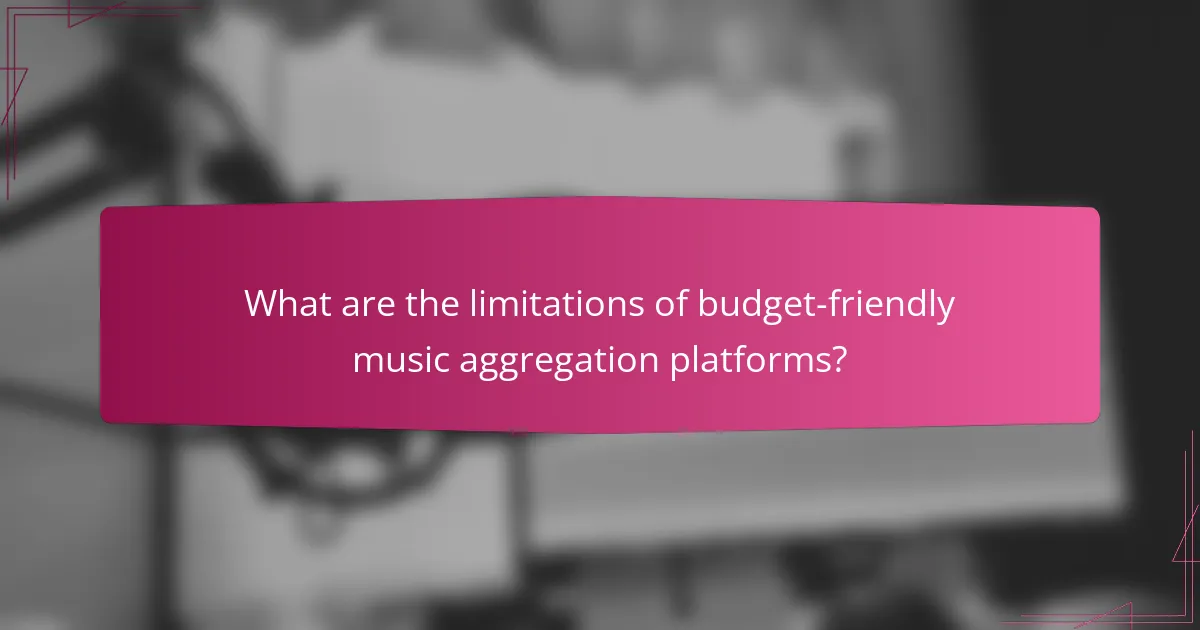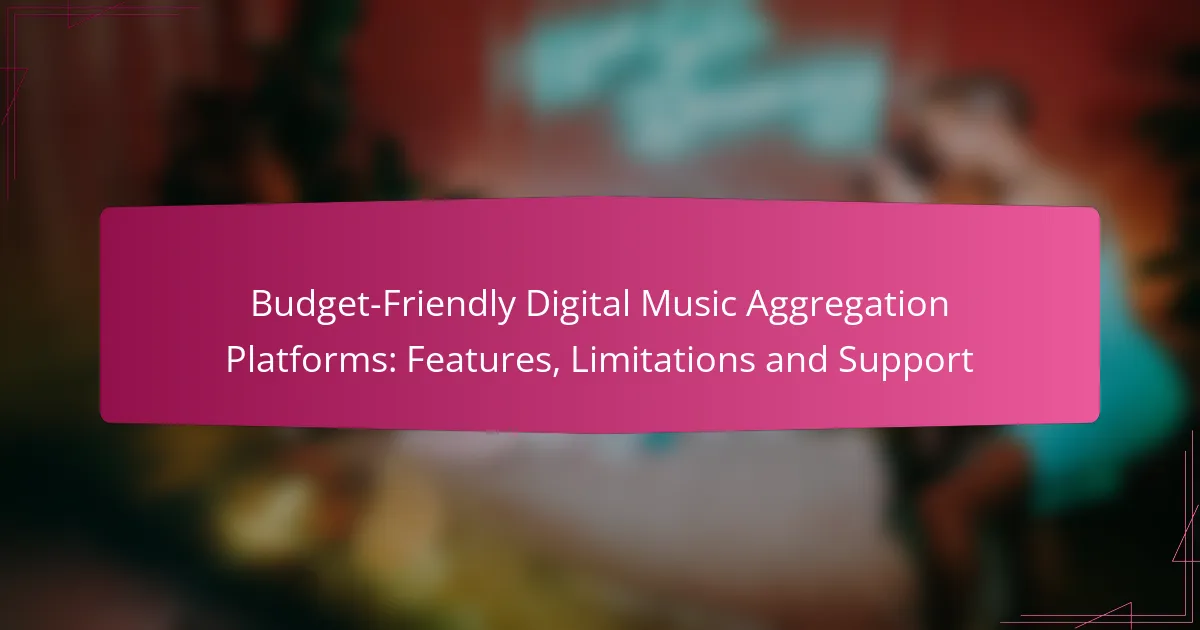Budget-friendly digital music aggregation platforms provide independent artists with an affordable way to distribute their music across various streaming services. While these platforms offer essential features like royalty collection and user-friendly interfaces, they may also come with limitations such as distribution fees and reduced support. When choosing a platform, it’s important to consider factors like distribution reach, royalty rates, and available reporting tools to maximize your success.

What are the best budget-friendly digital music aggregation platforms?
The best budget-friendly digital music aggregation platforms allow independent artists to distribute their music widely without incurring high costs. These platforms typically offer various features, including streaming service access, royalty collection, and user-friendly interfaces, while balancing limitations like distribution fees or revenue sharing.
Soundrop
Soundrop is a popular choice for independent musicians looking to distribute cover songs and original tracks. It offers a straightforward pricing model, charging a small fee per release, which makes it budget-friendly for artists just starting out.
One key feature of Soundrop is its ability to handle licensing for cover songs, ensuring that artists comply with copyright regulations. However, artists should be aware that Soundrop takes a percentage of the royalties earned from cover songs, which can impact overall earnings.
Amuse
Amuse provides a free tier for music distribution, making it an attractive option for emerging artists. With Amuse, users can distribute their music to major streaming platforms without upfront costs, although the free version limits some features.
For those seeking additional services, Amuse offers a paid plan that includes faster release times and access to advanced analytics. Artists should consider their growth trajectory when choosing between the free and paid options to maximize their investment.
RouteNote
RouteNote is known for its flexible pricing structure, allowing artists to choose between a free distribution model with revenue sharing or a paid option that offers 100% of royalties. This flexibility makes it suitable for various budgets and artist needs.
One limitation to consider is that the free model requires artists to share a portion of their earnings, which may not be ideal for those aiming for maximum profit. However, RouteNote’s extensive reach to numerous platforms can be beneficial for increasing visibility.
Bandcamp
Bandcamp stands out as a platform that not only allows music distribution but also enables artists to sell directly to fans. Artists can set their own prices and keep a significant portion of the revenue, making it a great option for those looking to maximize earnings.
While Bandcamp does charge a small fee on sales, the platform’s focus on community and fan engagement can lead to higher sales for dedicated artists. It’s essential for musicians to actively promote their Bandcamp page to leverage its full potential.
DistroKid
DistroKid is a subscription-based service that allows unlimited music uploads for a flat annual fee. This model is particularly appealing for prolific artists who release multiple tracks or albums each year, as it eliminates per-release costs.
However, artists should note that DistroKid does not offer a free tier, which may be a barrier for some. Additionally, while DistroKid provides rapid distribution to major platforms, artists must manage their own marketing efforts to ensure their music reaches a wider audience.

What features should you consider in a music aggregation platform?
When selecting a music aggregation platform, focus on features that enhance your distribution, maximize earnings, and provide valuable insights. Key aspects include distribution reach, royalty rates, reporting tools, and customer support options.
Distribution reach
Distribution reach refers to the number of digital platforms where your music can be made available. A good aggregation service should connect you to major streaming services like Spotify, Apple Music, and Amazon Music, as well as smaller platforms that cater to niche audiences.
Consider platforms that offer global distribution to ensure your music can reach listeners in various countries. Some services may also provide options for regional focus, which can be beneficial if you have a specific target market.
Royalty rates
Royalty rates are crucial as they determine how much you earn from your music sales and streams. Most aggregation platforms take a percentage of your earnings, typically ranging from 10% to 30%, so it’s essential to compare these rates when choosing a service.
Look for platforms that offer transparent royalty structures and favorable terms, especially if you plan to release a significant volume of music. Some platforms may also offer higher rates for exclusive releases or promotional deals.
Reporting tools
Effective reporting tools provide insights into your music’s performance across different platforms. Look for aggregation services that offer detailed analytics on streams, downloads, and revenue, allowing you to track your success and make informed decisions.
Some platforms provide real-time data, while others may offer monthly summaries. Choose a service that aligns with your needs for tracking and analyzing your music’s performance to optimize your marketing strategies.
Customer support options
Customer support is vital, especially if you encounter issues with your music distribution. Look for platforms that offer multiple support channels, such as email, live chat, and phone support, to ensure you can get help when needed.
Check for user reviews regarding the responsiveness and effectiveness of customer support. A platform with strong support can help you navigate challenges quickly, minimizing potential disruptions to your music release schedule.

What are the limitations of budget-friendly music aggregation platforms?
Budget-friendly music aggregation platforms often come with several limitations that can affect artists’ reach and earnings. These platforms typically offer fewer features and lower support compared to premium services, which can impact an artist’s overall success.
Limited store access
Many budget-friendly music aggregation platforms provide access to a limited number of digital stores. While they may include major platforms like Spotify and Apple Music, they often exclude smaller or niche stores that could be valuable for specific audiences. This restricted access can hinder an artist’s ability to reach diverse listeners.
When choosing a platform, consider which stores are essential for your music genre and target audience. If your music fits a niche market, ensure the aggregator includes stores that cater to that demographic.
Lower royalty payouts
Artists using budget-friendly music aggregation platforms typically receive lower royalty payouts compared to those using premium services. These platforms may take a higher percentage of sales or offer fixed rates that are less favorable, resulting in reduced income for artists. For instance, some platforms might offer payouts in the low tens of percent range for each stream or download.
To maximize earnings, artists should carefully review the payout structures of different aggregators. It’s essential to calculate potential earnings based on expected streams and sales to determine if the platform aligns with your financial goals.
Fewer promotional tools
Budget-friendly music aggregation platforms often lack advanced promotional tools that can help artists market their music effectively. Features such as pre-save campaigns, social media integration, and detailed analytics may be limited or absent. This can make it challenging for artists to build their audience and track their performance.
When selecting a platform, assess the promotional tools available and consider how they can support your marketing strategy. If promotion is a key priority for you, it may be worth investing in a platform that offers comprehensive marketing features, even if it comes at a higher cost.

How to choose the right digital music aggregator?
Selecting the right digital music aggregator involves assessing your specific distribution needs, comparing pricing models, and evaluating user reviews. Each aggregator offers unique features and limitations that can significantly impact your music’s reach and your overall costs.
Assess your distribution needs
Understanding your distribution needs is crucial when choosing a digital music aggregator. Consider where you want your music to be available—major platforms like Spotify, Apple Music, and Amazon Music, or niche services that cater to specific genres or audiences.
Think about the geographic reach you desire. Some aggregators focus on specific regions, while others provide global distribution. If you aim to target a local audience, select a service that emphasizes local platforms and playlists.
Compare pricing models
Different digital music aggregators offer various pricing structures, including one-time fees, annual subscriptions, or percentage cuts from your earnings. For instance, some may charge a flat fee per release, while others take a percentage of your royalties, which can range from 10% to 30%.
Evaluate your budget and expected revenue to determine which model is most cost-effective for you. If you plan to release multiple tracks or albums, an aggregator with a flat fee might be more economical in the long run.
Evaluate user reviews
User reviews provide valuable insights into the reliability and effectiveness of digital music aggregators. Look for feedback on customer service, ease of use, and the success of music distribution. Platforms like Trustpilot or Reddit can be good sources for honest opinions.
Pay attention to recurring themes in reviews, such as issues with payout delays or difficulties in navigating the platform. This information can help you avoid potential pitfalls and select an aggregator that aligns with your needs and expectations.

What support options are available for users of music aggregation platforms?
Music aggregation platforms typically offer several support options to assist users with their needs. These options include email support, live chat assistance, and community forums, each catering to different preferences and urgency levels.
Email support
Email support is a common option for users seeking assistance with music aggregation platforms. Users can submit their inquiries or issues via email, allowing for detailed explanations and attachments if necessary. Response times can vary, often ranging from a few hours to a couple of days, depending on the platform’s workload.
When using email support, it’s advisable to provide clear and concise information about the issue to expedite the response. Including relevant details, such as account information and specific problems, can help the support team address your concerns more effectively.
Live chat assistance
Live chat assistance offers real-time support for users who need immediate help with their music aggregation platform. This option is typically available during business hours and connects users directly with a support representative. Many platforms find this method effective for resolving quick questions or troubleshooting issues.
To make the most of live chat, prepare your questions in advance and be ready to provide any necessary account details. This can lead to faster resolutions and a more efficient support experience.
Community forums
Community forums serve as a valuable resource for users of music aggregation platforms, allowing them to share experiences and solutions. These forums are often moderated by the platform’s support team and can provide insights from other users facing similar challenges. Engaging in these discussions can lead to helpful tips and best practices.
While community forums can be a great source of information, it’s important to verify any advice received, as not all suggestions may be applicable to your specific situation. Regularly checking these forums can keep you informed about updates and common issues within the platform.
